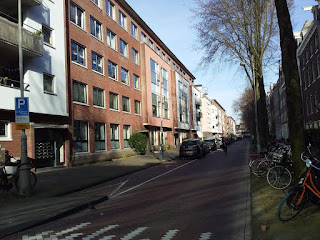I enjoyed writing my previous post so here are some more pictures of the Jewish quarter than and now. What is very interesting is that when all these re-buildings happened (mostly after WW2) there was not much concern about historical value of the old buildings - which were, mainly, badly neglected but not without a chance to save and perhaps reconstruct - so for various reasons, the whole streets were erased right in the centre of town and it took few decades before someone finally said "Stop, we must keep and protect our historical buildings" - I think the turnaround started in 1970s but unfortunately before that a lot of beautiful old houses were destroyed.
What you see on these pictures don't exist anymore. Right in the heart of the centre, near famous Nieuwmarkt, the whole street Keizersstraat has been demolished in order to make space for new buildings - I am not 100% sure but these beautiful old houses might be victims of the new underground line that was eventually done nearby. Apparently the locals were not amused and there were huge riots with police involved. I have no idea who came up with these horrible designs and who assumed that these new buildings will be better than what was previously here. It is such ugly and intimidating sight right in the middle of otherwise charming and historical area, that I avoid even walking there.
Not far from this monstrosity is a famous Flea market - as I have mentioned previously, this whole area was once a crowded Jewish quarter and after WW2 everything was erased and swept under the rug, except Rembrandtshuis which stood here since centuries ago and thankfully everybody understood its historical value. Right at the corner there used to be something else entirely and nowadays there is a strange construction that might be fine elsewhere but have absolutely nothing to do with old historical centre and the cute churchyard behind it. It pains me to walk here.
I do understand that after WW2 city officials wanted to re-build the old, neglected neighbourhoods and make space for new apartments, offices and different kinds of buildings, however when compared before and after, I can't help but to feel alarmed with such cold-heartedness - the whole areas were erased, removed and rebuilt in such a decidedly unsentimental manner that it often seems almost like sadistic disregard for the city. This is Valkenburgerstraat.
Nearby used to be Markenplein that was basically completely erased - this was also a heart of Jewish district and was brimming with old, historical houses - however because its such good location, city officials decided they need roads and tunnels and whatnot to go exactly here on this spot so never mind the old buildings, everything must go and it was eliminated. What you see nowadays gives absolutely no glimpse into what used to be a busy neighbourhood.
On the pictures above is Rapenburgerstraat, another victim of re-building. Since this was deep in the heart of Jewish quartier, most of its citizens were arrested and deported during WW2. Imagine the whole street packed away in concentration camps, horrible. If you walk here nowadays, you would probably never guess this used to be a completely different neighbourhood. Apartment buildings and its all very quiet but I dislike such disregard for history.
In the middle of all this, there is a tiny house with a old, historical entrance - I was immediately smitten and intrigued to find out what is this. It turned out that it used to be a corridor into a extremely poor courtyard and the whole area was actually a slum - long ago there used to be a gunpowder factory here. The house was called Bussenschuthofje (Bus shelter) but the meaning of this name was lost long time ago. Several families used to live in a courtyard houses and the old photos show very desolate and depressing backside of this entrance. It looks as property was changing hands very often and somehow, miraculously this entrance was saved, protected and kept all this time. If you walk today trough what is basically a completely new street, its the most charming little mystery. I absolutely love it.
The square Waterlooplein actually deserves its own chapter and essay because this used to be a heart of the Jewish quarter and for centuries served as a marketplace for Jewish street traders. Dominated by The Mozes en Aäronkerk (which thanks God, still stands here) the square was always a crowded street market and trough decades was one of the most popular spots in the city. During WW2 it became gathering place for raids, than houses around it became empty and deserted (as the people got arrested and deported), locals helped themselves with wood for fire during the war and eventually it became a ugly reminder of all the atrocities made here trough the war. Instead of finding some decent way to remember hundreds of people who used to live here, the city officials decided the best thing to do would be to erase everything and build apartment buildings, a new city hall and Opera house here. To me it feels and looks as the heart of city was forcefully pulled away and replaced with some plastic Lego pieces. Everything except Church is now completely new and it looks nothing like what it used to be.

























No comments:
Post a Comment